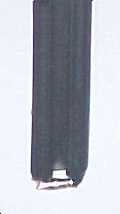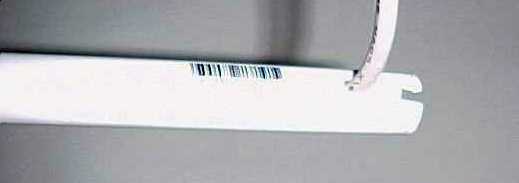Making your JPole Antenna -
Adapted design from
Bob
Hejl - W2IK and WD4JR
Take
one length (based on chart)
of 300 ohm twin lead (buy this from your local Radio Shack) This is the old
type of TV twin lead we had on our TVs as kids. USE A NEW LENGTH, not an old
run of wire ripped off from your house!!
On one
end, strip off about 1/2 inch of the insulation, exposing the parallel wires.
Bend them towards each other so they TOUCH or overlap. Solder them together,
making a nice, neat, tight connection. This is the bottom of your antenna.
Next,
measure exactly (based on chart)
from the end that you shorted together and cut a notch in ONE of the wires in
the twin lead. The notch should be about 1/4 of an inch.
Next,
measure exactly (based on chart)
from the same bottom of the shorted ends and strip the insulation exposing
about 1/4 of an inch of the wires on BOTH sides of the twin leads. At these
two points, CAREFULLY solder in place a 25 foot length of RG58 cable,
with the center conductor soldered to the long run (un-notched side of the
twin lead) and the shield side soldered to the notched side. (Trust me on
this. It should NOT be the other way around no matter whatever you've read or
been told).
Make a nice tight seal where the coax is attached to the twin-lead with shrink
tube or tape to extend to cover the entire lower section of the twin-lead as
shown.
Left: Bottom of twin-lead shorted as per text.
Center: Notch on ONE conductor 16 1/2 inches from the bottom



Double
check all your connections and then carefully use shrink tube or electrical
tape to cover the bottom of the twin lead while holding the coax cable tightly
against it so it makes a solid seal. Make sure that the coax connections to
the twin lead aren't shorting together. Continue taping it until it seals all
the connections you have made including the shorted bottom of the twinlead and
beyond to just the coax cable for about 2 inches. This will seal all of the
connections and add strength to your antenna/coax connection
(right
photo above). Add a PL-259
connector to the end of the coax. Have an adapter handy so you can use this
antenna with either your mobile radio or your HT.
At
this point, due to variations in twinlead construction, you will need to "tune"
the antenna by slipping it into a piece of 1/2 inch PVC tubing. Cut the
tubing several inches longer then the finished length of antenna. Hang it
vertically, keeping it away from metal objects. Use a fellow ham's antenna
analyzer to make adjustments as explained next. It will probably be a bit long,
so the resonant frequency measured will be low.
Slide
the twinlead out from the pvc and trim the top of the twinlead, by removing
1/4 of an inch from the top of the twinlead AND on the side that has the
notch: for each 1/4 inch you have cut from the top of the twinlead notch out
an additional 1/32 of an inch enlarging the original notch from the bottom of
the notched area... like you'd be increasing the original notch length (but
not really, just trimming the "short" side of the parallel lead). Do this
until it tunes lowest SWR on the version of antenna you selected when it is
back in the pvc. (If you do not adjust it in this manner, you'll never get
the lowest SWR or widest bandwith.
Cutting the PVC
Pipe
Take
a piece (based on completed antenna length) of 1/2 inch PVC pipe (you can
use the same pipe you used to tune that antenna) and on one end cut a 1 1/2 inch
long slot about 1/4 inch wide. Snake the twin lead "J Pole" down into the pipe
from this same end. When you see the twin lead appear at the other end, stop. By
this time, the entire antenna has made it's way into the pvc along with several
inches of the coax cable. Now fit the coax into that slot you've cut so the coax
comes out from the side. Using the proper pvc "glue", cement a pvc end cap to
the top of the antenna, where the twin lead was starting to come out. There is
no need to secure the antenna into the pvc as it will not collapse down.

Next,
take a 1/2 inch PVC coupler and cement it on to the end of the pvc tubing that
has the coax coming out the side. Take an additional 9 inch piece of pvc pipe
and cement it into the other end of the coupler. Then put a small amount
of coax seal where the coax has come out of the slot. This will prevent moisture
from entering the pipe where the coax exits the pipe. Leave the bottom of
the antenna open.
When
you are done, it should look like this at the coax end:

Next secure the cable to the
coupler with 2 black UV resistant wire ties to prevent the coax
along
with the antenna, from being pulled down.
Attach the antenna to your
mast or tower using stainless steel hose clamps. Attach additional coax
using a coupler to extend the length to the shack.







